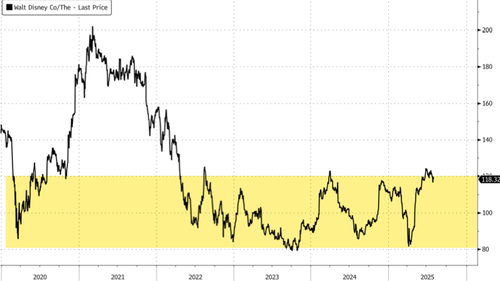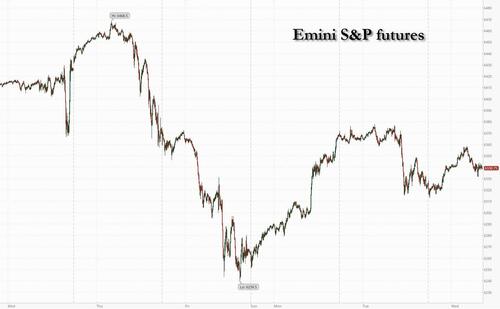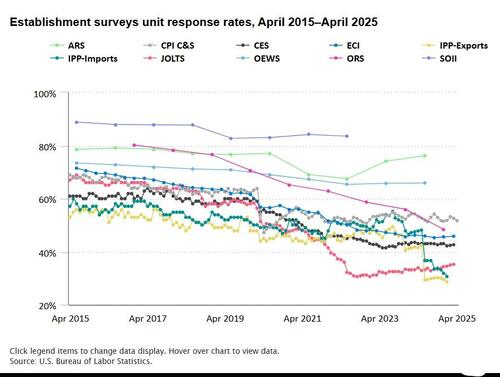‘Sabotage’: Thoughts On Trump’s BLS Director Tirade
“Listen all y’all, it’s a sabotage
Listen all y’all, it’s a sabotage
Listen all y’all, it’s a sabotage
Listen all y’all, it’s a sabotage
I can’t stand it, I know you planned it
I’m gonna set it straight, this Watergate
Lord, I can’t stand rockin’ when I’m in this place
Because I feel disgrace because you’re all in my face
But make no mistakes and switch up my channel
I’m Buddy Rich when I fly off the handle
What could it be? It’s a mirage
You’re scheming on a thing, that’s sabotage”
After the almost unprecedented jobs revisions last week, Trump came out swinging> Incompetency at best, he declared, and intentional sabotage at worst.
I agree with the first accusation.
The BLS has been struggling with data integrity for a looong time.
As for the second accusation – that it has been intentional – possibly.
Someone has been rigging the data in very obvious ways. But I don’t think it was political.
PROBLEM #1: Garbage in, Garbage Out
There has been a general decline in the response rates for government data surveys.
When you ask 100,000 companies to declare payrolls, and only 40,000 respond, the data gets skewed. Fore example, I would guess that companies with HR departments are more likely to send back a survey versus Joe’s Pizza shop. That, in turn, means that the payrolls under-represent smaller businesses. And since smaller companies typically are more sensitive to changes in economic winds, that means the data lags.
And that means that big decisions made by the Fed are laggy.
KILLING THE WRONG MESSENGER
Who is Erika McEntarfer, the ex-Director of the BLS? Let me start by saying that I don’t know any of the players and I don’t have contact with the BLS or have detailed insight into the minutia of their process. But the basics are self-evident: she is a scapegoat.
McEntarfer has a PhD in Economics and started her career as an economist with the Census Bureau. She quickly moved into an advisory role on the topic of labor markets. She was a member of the Council of Economic Advisors before becoming the BLS Director in January 2024.
Boiled down, McEnterfer is a very credentialed labor economist.
Does she have experience managing large organizations? Not that I see.
Does she have familiarity with the data gathering process unique to the BLS? No, but she has some tangential experience and knows the general problem.
McEnterfer as scapegoat
Generally speaking, the BLS Director role is less functional and more of a political reward. The Director blesses the work that is assembled by the actual mechanics assembled
Unfortunately for Erika, she was given the mandate of fixing the data collection problem.
That’s unfair because all agencies have the same problem and they were jointly trying to address it.
Also bad for Erika: in typical government fashion, the fix was taking years and the data credibility just got worse.
Strike One: Annual Revision Cuts 810K jobs in March. Instead of the rosy picture painted of the 2024 economy (2.8M jobs!!), a more sluggish 2M jobs were created. Worse, that level of correction was unprecedented (except for during the madness of COVID)
Strike Two: The recent NFP report removed 280K jobs for May and June. Just days before, Fed Chairman Powell pushed back on interest rate cuts because of a strong jobs market narrative.
Trump did not wait for Strike Three.
Many have accused Trump’s firing of McEntarfer as harming the credibility of an important government institution. In fact, that damage was already done by the institution itself.
Bottomline: In California (a la the Pacific Palisades fire), leaders can retain their jobs even when massive incompetency happens on their watch. Under Trump, leaders get fired if there are screw-ups. (One could argue that Trump is selective in his firings. For example, Secretary of Defense Hegseth’s using Signal to communicate war details was incompetence of a kind, but since it wasn’t directly tied to his prosecution of duties over the Pentagon, he was forgiven.)
EVIDENCE OF DATA SKEWING: THE WHAT BUT NOT THE WHO AND WHY
For the past months I have pointed to two very obvious signs of tinkering with the payroll data.
Let me revisit them.
Example #1: Creating 98K jobs out of nowhere.
In April, 98K materialized out of nowhere, boosting the April NFP substantially.
You can go back in time for decades, but something of this scale has never happened (COVID excepted). That is, the typical monthly payroll growth for this sector is ~15K, with a peak of around 22K. Nowhere near 98K
Also, the jump came and went in just one month. When a sector is growing or fading, it does so in a wave.
This is 100% data manipulation.
Example #2: Public Sector Education
In the June preliminary NFP report, ~70K jobs came from the State and Local public education sector. Somehow, schools retained more workers than they have in decades. It was even more unbelievable when you consider that these schools have a lot more staff and even more seasonal workers to layoff.
THE DEVIL IN THE DETAILS
Maybe this wasn’t intentional. We’ve all heard stories about a junior banker accidentally fat fingering the data entry and sending billions instead of millions.
The question is why wasn’t this detected.
In both examples, someone accidentally or intentionally changed the data.
I saw it immediately, within minutes of the data releases.
Yet how many eyes at the BLS looked at this and saw no problem? Because this demonstrates that issues go beyond data collection and are specific BLS oversight problems. Was the Director of the BLS simply not paying sufficient attention to her organization’s single most important product? She clearly has the capability. (Reinforces my view that she is just a figurehead and responsible for the mess only insofar as it’s happening under her watch.)
TO THE PARANOID, A WEB OF DECEPTION
Trump has reasons to suspect government bureaucracies are out to get him. In the ebb-and-flow of economic data, he sees a pattern that suggests political sabotage. namely, boosting Biden when it mattered, and undermining Trump when it hurts the most:
Election year In the run-up to the election, the Fed cuts rates and the BLS reports solid jobs data. Both actions are positive for Biden.
March Jobs Revisions After the election, the BLS says “oops! Things were bad after all.”
Super weak jobs report in July In the run up to the critical July Fed meeting about interest rate cuts, the BLS reports months of solid payrolls. After the Fed decides not to cut rates, the entire ‘strong jobs’ narrative is completely destroyed by BLS data revision
I don’t think that they are out to get you, Mr. President.
Trump should welcome the revisions that say the jobs market is weak. It supports his effort to get rate cuts. He just doesn’t like being tarred with a weak economy.
I do think that there is an institutional bias that overstates jobs.
Or at least that there was an institutional bias until recently.
At the same time, mysteries remain
Who did this? I go back to the data fudging examples that I found. These weren’t the result of model mechanics that add 20K jobs a month. These jobs simply did not happen and were very large and impactful (in fact the public sector education example from June was eliminated in the July revision). Somebody created them out of thin air. Just as somebody decided to remove them.
And why? Why these bizarre job-pumping moves? And why the big unwinding?
Tyler Durden
Wed, 08/06/2025 – 08:05













